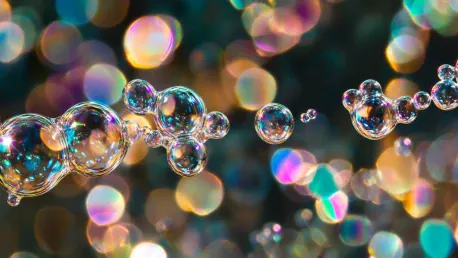The field of biochemical engineering is witnessing an innovative approach with the development of fine-bubble engineering techniques. By focusing on the manipulation of both nanobubbles (NBs) and microbubbles (MBs), researchers aim to improve the efficiency and effectiveness of various bioprocess applications. This novel method involves influencing liquid properties through advanced engineering practices, thus presenting promising solutions for processes such as wastewater treatment, algaculture, fermentation, and brewing.
The Challenge of Maintaining Dissolved Oxygen Levels
Limitations of Gas Solubility in Liquids
One of the primary challenges faced in biochemical engineering and environmental bioprocesses is the maintenance of adequate dissolved oxygen (DO) levels in liquids. Gas solubility in liquids is inherently limited by Henry’s Law, which states that the solubility of gas decreases as temperatures increase. This fundamental principle can lead to significant environmental and process-related issues, such as fish kills and algal blooms during hot summer months, when natural water bodies experience elevated temperatures. In industrial bioprocesses, consistent levels of dissolved gases like oxygen and carbon dioxide are critical for maintaining productivity and overall process efficacy.
The Role of Fine Bubbles in Addressing Gas Solubility
Despite these challenges, fine bubbles—particularly nanobubbles—offer a promising solution for maintaining necessary dissolved gas levels. These minute bubbles have the capability to manipulate liquid properties in a dynamic and time-dependent manner. According to Stokes’ Law, the rate at which bubbles rise through a liquid is inversely related to their size, with smaller bubbles ascending more slowly. By meticulously controlling the size of these bubbles, it is possible to manage the dispersed bubble phase, thereby matching the timing of gas solubility with the residence time of the bioprocess. This innovative approach ensures optimal synchronization between gas saturation and process efficiency, ultimately reducing operational costs.
Engineering Fine Bubbles for Bioprocess Enhancement
Nanobubbles: A Central Focus
Nanobubbles play a pivotal role in advancing fine-bubble engineering practices. These tiny gas bubbles, which are on the nanometer scale, exhibit thermodynamic metastability, allowing them to persist in liquids for extended periods—potentially several months. Their enhanced gas-transfer properties make them particularly advantageous for sustainable bioprocess optimization. Given their diminutive size, nanobubbles are invisible to the naked eye and are vastly smaller than a human hair. AquaB’s state-of-the-art NB generation method capitalizes on static electric fields and electrostriction-based phenomena to create exceptionally dense nanobubbles. This process ensures prolonged stability, thereby maintaining high levels of dissolved gases in liquids over time.
Microbubbles: Essential for Nanobubble Generation
While microbubbles (MBs) have a relatively short lifespan of a few hours, they are instrumental in the generation of nanobubbles. Fine-bubble engineering endeavors to optimize the processes involved in generating both MBs and NBs. AquaB Nanobubble Innovations Ltd, a spin-out from University College Dublin’s Chemical Engineering department, has been at the forefront of commercializing these advanced technologies. The company focuses on innovative and energy-efficient NB generation and has developed a line of Technology Readiness Level (TRL) 4-8 NB generators. These cutting-edge devices are slated for full commercial launch by the first quarter of 2025, promising to revolutionize the field with their advanced design and functionality.
Practical Applications and Collaborations
Enhancing Shellfish-Farm Water with Ozone Nanobubbles
An impressive collaboration in the realm of fine-bubble engineering involved the application of longer-lived ozone NBs in shellfish-farm water. When compared to traditional macro-bubbling techniques, these ozone NBs significantly reduced the reliance on parallel UV irradiation. The enhanced oxidative potency of the water due to the nanobubbles has substantial benefits for norovirus suppression and energy-efficient water treatment. This innovative approach holds significant promise for improving aquaculture practices and contributing to the overall health and safety of shellfish farming environments.
Biomimetic Swirl Patterns for Effective Microbubble Formation
In another groundbreaking application, researchers tested and validated the use of Schauberger-flow vortices from Turritech in fine-bubble engineering. These biomimetic swirl patterns leverage natural water-flow momentum to optimize eddy-current cavitation, which is crucial for effective MB formation. The resultant microbubbles temporarily enhance the oxidative properties of water, demonstrating the potential bio-friendly applications of fine-bubble engineering. This technique not only improves water-treatment processes but also underscores the environmentally sustainable advantages of integrating biomimetic principles into bioprocess engineering.
Improving Biomass Yield in Marine-Algal Species
Collaborations with Saudi Aramco have further showcased the practical benefits of fine-bubble engineering. In these projects, AquaB’s electro-generated CO2 NBs were applied to marine-algal species, leading to significant improvements in biomass yield. By tailoring upstream meso-bubble populations and exposing them to electric fields, researchers achieved noteworthy enhancements in algal growth. The findings, presented at the Nanobubbles 2024 conference in Kyoto, underscore the tangible benefits of fine-bubble engineering in optimizing bioprocess efficiency and promoting sustainable production of valuable marine-algal biomass.
Future Prospects and Industrial Applications
AquaB’s Commercial Rollout and Certification
AquaB is preparing for a major commercial rollout with their TRL-9 and CE-marked, IP- and ATEX-rated NB generators. These advanced devices are anticipated to achieve ISO certification and independent verification for their high nanobubble presence and performance, positioning AquaB as a global leader in NB production. The effectiveness of these engineering processes in managing MB populations is crucial, as MBs are a requisite precursor for subsequent NB generation. Through these innovations, AquaB is poised to make significant strides in the field of fine-bubble engineering, offering advanced solutions for a variety of industrial applications.
Aligning with Sustainable Development Goals
The field of biochemical engineering is currently experiencing significant advancements with the introduction of fine-bubble engineering techniques. This innovative approach focuses on the manipulation of nanobubbles (NBs) and microbubbles (MBs) to enhance the efficiency and effectiveness of various bioprocess applications. Researchers are employing these techniques to influence the properties of liquids, leading to promising solutions for several critical processes. For example, in wastewater treatment, fine-bubble technology can improve the breakdown of pollutants by increasing the oxygen transfer rates. In algaculture, it helps in the optimal growth of algae by finely distributing nutrients and gases throughout the culture medium. Similarly, in fermentation and brewing, the enhanced gas-liquid interaction ensures better product quality and consistency by optimizing microbial activity and gas exchange. By employing advanced engineering practices to control bubble formation and behavior, researchers can achieve more efficient and sustainable outcomes in a variety of industries, heralding a new era of innovation in biochemical engineering.









